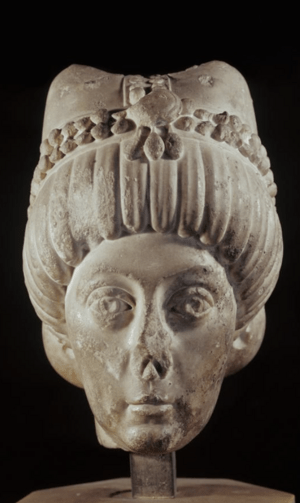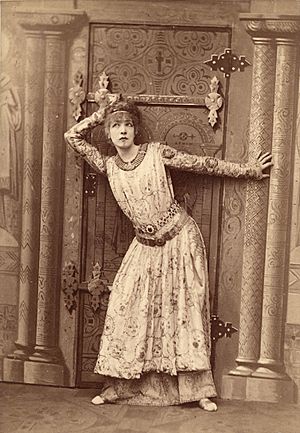Theodora (wife of Justinian I) facts for kids
Quick facts for kids Theodora |
|
|---|---|
| Augusta | |
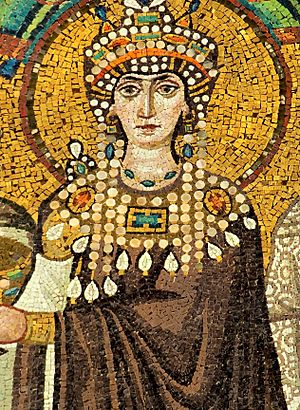
Depiction from a contemporary portrait mosaic in the Basilica of San Vitale, Ravenna
|
|
| Byzantine empress | |
| Tenure | 1 April 527 – 28 June 548 |
| Born | c. 500 |
| Died | 28 June 548 (aged 48) Constantinople, Byzantine Empire |
| Burial | Church of the Holy Apostles |
| Spouse | Justinian I |
| Dynasty | Justinian |
| Religion | Christianity (Miaphysitism) |
Theodora ( Greek: Θεοδώρα; c. 500 – 28 June 548) was an empress of the Eastern Roman Empire. She became empress by marrying Emperor Justinian. Theodora became empress when Justinian took the throne in 527. She was one of his most important advisers, even though she came from a simple background. Both Theodora and Justinian are considered saints in the Eastern Orthodox Church and the Oriental Orthodox Church. They are remembered on November 14 and June 28.
Contents
Theodora's Early Life
Not much is known about Theodora's early life. She was born around the year 500 AD. Her father, Acacius, trained bears for shows at the hippodrome in Constantinople. He worked for the Green team, which was one of the racing groups. Her mother was a dancer and actress, but her name is not known. Theodora had two older sisters, Comito and Anastasia. After her father died, her mother quickly remarried, but the family was very poor.
From a young age, Theodora performed on stage. Later, she traveled to Alexandria, Egypt. Some historians think she met Patriarch Timothy III there. He was a leader of the Miaphysite Christian group. They believe she became a Miaphysite Christian at that time.
After her travels, Theodora returned to Constantinople. There, she met Justinian. Justinian wanted to marry Theodora. However, an old Roman law from Constantine's time stopped him. This law said that important senators could not marry actresses. Empress Euphemia, who was married to Emperor Justin, also strongly opposed the marriage.
After Euphemia died in 524, Justin passed a new law. This law allowed actresses who had changed their lives to marry people of higher rank. But the emperor had to approve the marriage. Soon after, Justinian and Theodora were married.
Becoming Empress

In 527, two years after their marriage, Justinian became emperor. Theodora was crowned augusta and became empress of the Eastern Roman Empire. People at the time said she shared in Justinian's decisions and plans. She also took part in government meetings and had a lot of influence over him.
As Justinian's partner, Theodora shared his vision for the Byzantine Empire. Justinian believed there could only be one true Roman Empire. He also believed there was only one God. Because they were the only Christian Emperor and Empress, they felt it was their job to make their empire on Earth like heaven.
Justinian and Theodora were young rulers. They did not want things to stay the same. They had big goals, like building new churches and public buildings. They also wanted to raise large armies for military campaigns. All these projects needed a lot of money. Justinian and his money minister, John the Cappadocian, collected taxes strictly from the wealthy. The rich people did not like this.
The Nika Riots
Before and during Justinian and Theodora's rule, there were two main groups of people. These were called the Blues and the Greens. They often fought in the streets. When Justinian became emperor, he wanted to make the city more peaceful. In January 532, a riot broke out between these two groups.
The rioters set many public buildings on fire. They also declared a new emperor, Hypatius. He was the nephew of a former emperor. Justinian and his officials were unable to stop the crowd. They prepared to run away.
However, at a government meeting, Theodora spoke up. She argued against leaving the palace. She said it was better to die as a ruler than to live as an exile or in hiding. Her strong speech motivated Justinian, who had been ready to flee.
Afterward, Justinian ordered his loyal soldiers to attack the rioters. The soldiers were led by officers named Belisarius and Mundus. They attacked the protesters in the Hippodrome. More than 30,000 rebels were killed. Hypatius was also put to death by Justinian. Some sources say Theodora insisted on this.
Life After the Riots
After the Nika revolt, Justinian and Theodora rebuilt Constantinople. They built aqueducts, bridges, and more than twenty-five churches. The most famous church they built was Hagia Sophia. Justinian and Theodora also realized that people were unhappy with some of their actions. They started to watch their government more closely. They wanted to make sure their actions were fair to common citizens.
The couple still disliked the rich people who had tried to remove them from power. As a result, 19 senators who took part in the Nika revolt were executed. Their properties were also destroyed. The remaining wealthy people had to deal with strict taxes. These taxes helped pay for Justinian and Theodora's big rebuilding plans.
Justinian and Theodora also created new laws. These laws expanded the rights of women. Women gained more rights in divorce and property ownership. Mothers also gained some rights to care for their children.
Religious Beliefs
| Saint Theodora | |
|---|---|
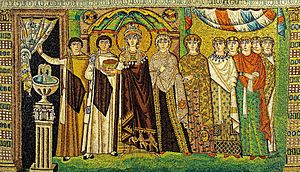
Empress Theodora and attendants (mosaic from Basilica of San Vitale, 6th century)
|
|
| Empress | |
| Venerated in | Eastern Orthodox Church Oriental Orthodox Church |
| Major shrine | Church of the Holy Apostles, Constantinople modern day Istanbul, Turkey |
| Feast | 14 November in the Eastern Orthodox Church, 28 June in the Syriac Orthodox Church |
| Attributes | Imperial Vestment |
Justinian wanted to reduce problems between different Christian groups. He believed that as the Christian emperor, he should work with the Church leaders. Justinian followed the Chalcedonian Christian beliefs. Theodora, however, believed in Miaphysite Christianity. Justinian tried to unite the churches in Constantinople and Rome. He wanted one united Church that would work with him as the one Emperor.
Theodora often worked against her husband's support of Chalcedonian Christianity. She was accused of supporting beliefs that went against the main Church. Some historians, like Procopius, even suggested that Justinian and Theodora only pretended to disagree.
Even though Justinian was Chalcedonian, Theodora built a Miaphysite monastery. She also gave shelter in the palace to Miaphysite leaders. These leaders faced problems from the majority of Chalcedonian Christians. For example, she helped Anthimus. He was hidden in Theodora's rooms for twelve years until she died.
In Egypt, when Timothy III died, Theodora helped a Miaphysite leader named Theodosius become the new Pope of Alexandria. She did this even though her husband wanted a Chalcedonian leader. Theodosius was later exiled by Justinian.
Theodora also helped spread Miaphysite Christianity in other areas. In Nobatae, south of Egypt, the people became Miaphysite Christians around 540. Justinian wanted them to be Chalcedonian. Theodora sent her own missionaries. She made sure her missionaries arrived before Justinian's. The Nobatae then adopted the Miaphysite faith.
Theodora's Death
Theodora died on June 28, 548, at the age of 48. The cause of her death is not fully known. The Greek words used often mean "cancer". Later accounts often say she died from breast cancer. However, the original report only used the general term "cancer." Her body was buried in the Church of the Holy Apostles in Constantinople. Justinian visited her tomb and lit candles for her years later.
Theodora in History
The main historical information about Theodora comes from a writer named Procopius. He worked for Belisarius, a general under Justinian. Procopius wrote three different descriptions of Theodora.
His book The Wars of Justinian, finished around 545, shows her as a brave woman. She helped Justinian keep his throne.
Later, Procopius wrote Secret History. This book shows a more negative view of Justinian, Theodora, and Belisarius.
Procopius's Buildings of Justinian was likely written after Secret History. This book praises Justinian and Theodora. It describes them as a religious couple and praises Theodora's beauty. It's important to remember that Theodora had already died when this book was published. Justinian was still alive and probably asked for the book to be written.
Other writers also mentioned Theodora. John of Ephesus wrote about her in his Lives of the Eastern Saints. Later Miaphysite writers, like Michael the Syrian, said Theodora was the daughter of a priest. They said she was raised with Miaphysite beliefs. Many modern scholars, however, prefer Procopius's account.
Theodora's Lasting Impact
The Miaphysites believed Theodora had a strong influence on Justinian. Even after her death, Justinian worked to bring peace between the Miaphysites and Chalcedonian Christians. He kept his promise to protect the Miaphysite refugees she had sheltered. The Miaphysites thought Theodora's memory was the reason for his actions.
Theodora also strongly supported Jacob Baradaeus, a Miaphysite leader. Many believe that Jacobite Christianity exists today because of both Baradaeus and Theodora.
A city in Cyrenaica (modern-day Libya) was renamed Theodorias after Theodora. This city, now called Qasr Libya, has beautiful sixth-century mosaics.
Theodora and Justinian are shown in mosaics in the Basilica of San Vitale in Ravenna, Italy. These mosaics were finished in 547. Theodora is shown in her royal clothes, covered in jewels. Her cloak has images of the three kings bringing gifts to the Christ child. This connects her to bringing gifts to the church. In the mosaic, she is shown holding a communion cup. Other mosaics show Theodora and Justinian receiving defeated kings as prisoners. These large artworks show the Emperor and Empress as victorious and generous.
Theodora in Media
- The famous artwork The Dinner Party includes a place setting for Theodora.
Movies
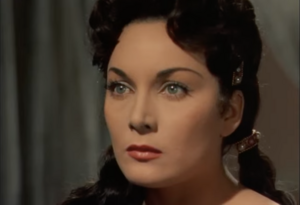
- Teodora imperatrice di Bisanzio (Short, 1909), also known as Theodora, Empress of Byzantium.
- Teodora, imperatrice di Bisanzio (1954), also known as Theodora, Slave Empress. Theodora was played by Gianna Maria Canale.
- Kampf um Rom (1968). Theodora was played by Sylva Koscina.
- Primary Russia (1985). Theodora was played by Margarita Terekhova.
Theater
- Theodora, a Drama (1884), a play by Victorien Sardou.
Music
- The band Big Big Train sings about Theodora in their song "Theodora in Green and Gold." This song is on their 2019 album Grand Tour.
- George Frideric Handel's oratorio "Theodora" is not about Empress Theodora.
See also
 In Spanish: Teodora para niños
In Spanish: Teodora para niños


